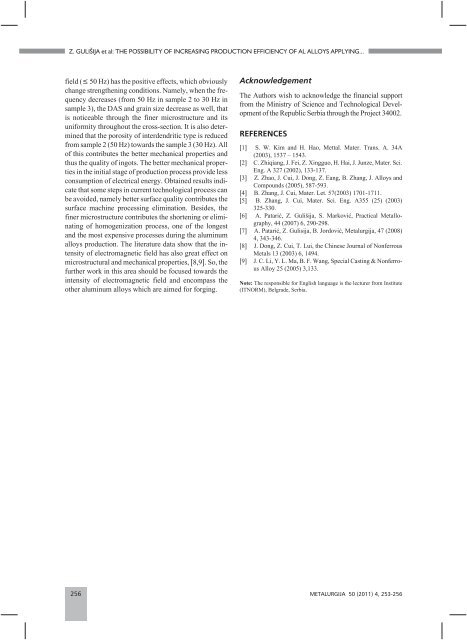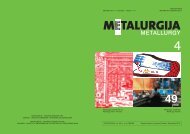PDF - 2453 kB - CARNet
PDF - 2453 kB - CARNet
PDF - 2453 kB - CARNet
You also want an ePaper? Increase the reach of your titles
YUMPU automatically turns print PDFs into web optimized ePapers that Google loves.
Z. GULI[IJA et al: THE POSSIBILITY OF INCREASING PRODUCTION EFFICIENCY OF AL ALLOYS APPLYING...<br />
field (� 50 Hz) has the positive effects, which obviously<br />
change strengthening conditions. Namely, when the frequency<br />
decreases (from 50 Hz in sample 2 to 30 Hz in<br />
sample 3), the DAS and grain size decrease as well, that<br />
is noticeable through the finer microstructure and its<br />
uniformity throughout the cross-section. It is also determined<br />
that the porosity of interdendritic type is reduced<br />
from sample 2 (50 Hz) towards the sample 3 (30 Hz). All<br />
of this contributes the better mechanical properties and<br />
thus the quality of ingots. The better mechanical properties<br />
in the initial stage of production process provide less<br />
consumption of electrical energy. Obtained results indicate<br />
that some steps in current technological process can<br />
be avoided, namely better surface quality contributes the<br />
surface machine processing elimination. Besides, the<br />
finer microstructure contributes the shortening or eliminating<br />
of homogenization process, one of the longest<br />
and the most expensive processes during the aluminum<br />
alloys production. The literature data show that the intensity<br />
of electromagnetic field has also great effect on<br />
microstructural and mechanical properties, �8,9�. So, the<br />
further work in this area should be focused towards the<br />
intensity of electromagnetic field and encompass the<br />
other aluminum alloys which are aimed for forging.<br />
Acknowledgement<br />
The Authors wish to acknowledge the financial support<br />
from the Ministry of Science and Technological Development<br />
of the Republic Serbia through the Project 34002.<br />
REFERENCES<br />
�1� S. W. Kim and H. Hao, Mettal. Mater. Trans. A. 34A<br />
(2003), 1537 – 1543.<br />
�2� C. Zhiqiang, J. Fei, Z. Xingguo, H. Hai, J. Junze, Mater. Sci.<br />
Eng. A 327 (2002), 133-137.<br />
�3� Z. Zhao, J. Cui, J. Dong, Z. Eang, B. Zhang, J. Alloys and<br />
Compounds (2005), 587-593.<br />
�4� B. Zhang, J. Cui, Mater. Let. 57(2003) 1701-1711.<br />
�5� B. Zhang, J. Cui, Mater. Sci. Eng. A355 (25) (2003)<br />
325-330.<br />
�6� A. Patari}, Z. Guli{ija, S. Markovi}, Practical Metallography,<br />
44 (2007) 6, 290-298.<br />
�7� A. Patari}, Z. Gulisija, B. Jordovi}, Metalurgija, 47 (2008)<br />
4, 343-346.<br />
�8� J. Dong, Z. Cui, T. Lui, the Chinese Journal of Nonferrous<br />
Metals 13 (2003) 6, 1494.<br />
�9� J. C. Li, Y. L. Ma, B. F. Wang, Special Casting & Nonferrous<br />
Alloy 25 (2005) 3,133.<br />
Note: The responsible for English language is the lecturer from Institute<br />
(ITNORM), Belgrade, Serbia.<br />
256 METALURGIJA 50 (2011) 4, 253-256

















